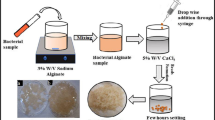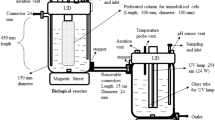Abstract
A locally isolated Acinetobacter sp. Strain AQ5NOL 1 was encapsulated in gellan gum and its ability to degrade phenol was compared with the free cells. Optimal phenol degradation was achieved at gellan gum concentration of 0.75% (w/v), bead size of 3 mm diameter (estimated surface area of 28.26 mm2) and bead number of 300 per 100 ml medium. At phenol concentration of 100 mg l−1, both free and immobilized bacteria exhibited similar rates of phenol degradation but at higher phenol concentrations, the immobilized bacteria exhibited a higher rate of degradation of phenol. The immobilized cells completely degrade phenol within 108, 216 and 240 h at 1,100, 1,500 and 1,900 mg l−1 phenol, respectively, whereas free cells took 240 h to completely degrade phenol at 1,100 mg l−1. However, the free cells were unable to completely degrade phenol at higher concentrations. Overall, the rates of phenol degradation by both immobilized and free bacteria decreased gradually as the phenol concentration was increased. The immobilized cells showed no loss in phenol degrading activity after being used repeatedly for 45 cycles of 18 h cycle. However, phenol degrading activity of the immobilized bacteria experienced 10 and 38% losses after the 46 and 47th cycles, respectively. The study has shown an increased efficiency of phenol degradation when the cells are encapsulated in gellan gum.






Similar content being viewed by others
References
Adav SS, Chen MY, Lee DJ, Ren NQ (2007) Degradation of phenol by Acinetobactor strain isolated from aerobic granules. Chemosphere 67:1566–1572
Adinarayana K, Jyothi B, Ellaiah P (2005) Production of alkaline protease with immobilized cells of B. subtilis PE-11 in various matrices by entrapment technique. AAPS Pharm Sci Tech 6:391–397
Aguayo J, Barra R, Becerra J, Martínez M (2009) Degradation of 2, 4, 6-tribromophenol and 2, 4, 6-trichlorophenol by aerobic heterotrophic bacteria present in psychrophilic lakes. World J Microbiol Biotechnol 25:553–560
Aksu Z, Bulbul G (1999) Determination of effective diffusion coefficient of phenol in Ca-alginate immobilized P. putida beads. Enzyme Microbiol Technol 25:344–348
American Public Health Association (1998) Standard methods for the examination of water and wastewater. 20th Edition. Method 5530. pp 540–544
Ashtaputre AA, Shah AK (1995) Studies on viscous, gel forming exopolysaccharide from Sphingomonas paucimobilis GS1. Appl Environ Microbiol 61:1159–1162
Beshay U, Abd-El-Haleem D, Moawad H, Zaki S (2002) Phenol biodegradation by free and immobilized Acinetobacter. Biotechnol Lett 24:1295–1297
Buckley JD, Meadows AT, Kadin ME, LeBeau AM, Siegel S, Robinson LL (2000) Pesticide exposures in children with non-Hodgkin lymphoma. Cancer 2:2315–2321
Camelin I, Lacroix C, Paquin C, Prevost H, Cachon R, Divies C (1993) Effects of chelants on gellan gum rheological properties and setting temperature for immobilization of living Bifidobacteria. Biotechnol Prog 9:291–297
Cassidy MB, Mullineers H, Lee H, Trevors JT (1997) Mineralization of pentachlorophenol in a contaminated soil by Pseudomonas sp. UG30 cells encapsulated in k-carrageenan. J Ind Microbiol Biotechnol 19:43–48
Čejková A, Masák J, Jirk V, Veselý M, Pátek M, Nevera J (2005) Potential of Rhodococcus erythropolis as a bioremediation organism. World J Microbiol Biotechnol 21:317–321
Chatterjee S, Das SK, Chakravarty R, Chakrabarti A, Ghosh S (2010) Interaction of malathion, an organophosphorus pesticide with Rhizopus oryzae biomass. J Hazard Mater 174:47–53
Chung TP, Tseng HY, Juang RS (2003) Mass transfer effect and intermediate detection for phenol degradation in immobilized Pseudomonas putida systems. Process Biochem 38:1497–1507
Dursun AY, Tepe O (2005) Internal mass transfer effect on biodegradation of phenol by Ca-alginate immobilized Ralstonia eutrophe. J Hazard Mater 126:105–111
González-Gutiérrez LV, González-Alatorre G, Escamilla-Silva EM (2009) Proposed pathways for the reduction of a reactive azo dye in an anaerobic fixed bed reactor. World J Microbiol Biotechnol 25:415–426
Ha J, Engler CR, Wild JR (2009) Biodegradation of coumaphos, chlorferon, and diethylthiophosphate using bacteria immobilized in Ca-alginate gel beads. Biores Technol 100:1138–1142
Hooiveld M, Heederick DJJ, Kogevinas M, Boffetta P, Needham LL, Patterson DG, Bas BJ, Bas BH (1998) Second follow-up of a Dutch cohort occupationally exposed to phenoxy herbicides, chlorophenol, and contaminants. Am J Epidemiol 147:891–901
Hori TSF, Avilez IM, Inoue LK, Moraes G (2006) Metabolical changes induced by chronic phenol exposure in matrinxã Brycon cephalus (teleostei: characidae) juveniles. Comp Biochem Physiol 143:67–72
Kumaran P, Paruchuri YL (1997) Kinetics of phenol biotransformation. Water Res 31:11–22
Lee CM, Lu CJ, Chuang MS (1994) Effects of immobilized cells on the biodegradation of chlorinated phenols. Water Sci Technol 30:87–90
Liu YJ, Zhang AN, Wang XC (2009) Biodegradation of phenol by using free and immobilized cells of Acinetobacter sp. XA05 and Sphingomonas sp. FG03. Biochem Eng J 44:187–192
Machado KMG, Matheus DR, Monteiro RTR, Bononi VLR (2005) Biodegradation of pentachorophenol by tropical basidiomycetes in soils contaminated with industrial residues. World J Microbiol Biotechnol 21:297–301
Moslemy P, Neufeld RJ, Guiot SR (2002) Biodegradation of gasoline by gellan gum- Encapsulated bacterial cells. Biotechnol Bioeng 80:175–184
Moslemy P, Neufeld RJ, Millette D, Guiot SR (2003) Transport of gellan gum microbeads through sand: an experimental evaluation for encapsulated cell bioaugmentation. J Environ Manag 69:249–259
Norton S, Lacroix C (1990) Gellan gum gel as entrapped matrix for high temperature fermentation process-rheological study. Biotechnol Tech A 4:351–356
Ozdemir G, Ceyhan N, Manav E (2005) Utilization in alginate beads for Cu(II) and Ni(II) adsorption of an exopolysaccharide produced by Chryseomonas luteola TEM05. World J Microbiol Biotechnol 21:163–167
Prieto MB, Hidalgo A, Rodriguez FC, Serra JL, Llama MJ (2002) Biodegradation of phenol in synthetic and industrial wastewater by Rhodococcus erythropitics. UPV-1 immobilized in air-stirred reactor with clarifier. Appl Microbiol Biotechnol 58:853–859
Revankar MS, Lele SS (2006) Increased production of extracellular laccase by the white rot fungus Coriolus versicolor MTCC 138. World J Microbiol Biotechnol 22:921–926
Sadouk Z, Tazerouti A, Hacene H (2009) Biodegradation of diesel oil and production of fatty acid esters by a newly isolated Pseudomonas citronellolis KHA. World J Microbiol Biotechnol 25:65–70
Sejákova Z, Dercová K, Tóthová L (2009) Biodegradation and ecotoxicity of soil contaminated by pentachlorophenol applying bioaugmentation and addition of sorbents. World J Microbiol Biotechnol 25:243–252
Shukor MY, Ahmad SA, Nadzir MMM, Abdullah MP, Shamaan NA, Syed MA (2010) Molybdate reduction by Pseudomonas sp. strain DRY2. J Appl Microbiol 108:2050–2058
Smit E, Lee H, Trevors JT, Elsas JDV (1996) Interaction between a genetically engineered Pseudomonas fluorescens and bacteriophage øR2f in soil: effect of nutrients, alginate encapsulation, and the wheat rhizosphere. Microb Ecol 31:125–140
Song L, Hua R, Zhao Y (2005) Biodegradation of fenoxaprop-p-ethyl by bacteria isolated from sludge. J Hazard Mater 118:247–251
Syed MA, Sim HK, Khalid A, Shukor MY (2009) A simple method to screen for azo-dye-degrading bacteria. J Environ Biol 30:89–92
Wang Y, Tian Y, Han B, Zhao HB, Bi JN, Cai BL (2007) Biodegradation of phenol by free and immobilized Acinetobacter sp. strain PD12. J Environ Sci 19:222–225
Weir SC, Dupuis SP, Providenti MA, Lee H, Trevors JT (1995) Nutrient enhanced survival of and phenanthrene mineralization by alginate encapsulated and free Pseudomonas sp. UG14Lr cells in creosote-contaminated soil slurries. Appl Microbiol Biotechnol 43:946–951
Whitely AS, Bailey MY (2000) Bacterial community structure and physiological state within an industrial phenol bioremediation system. Appl Environ Microbiol 66:2400–2407
Yadzir ZHM (2007) Characterization, identification and application of Acinetobacter baumannii SERDANG 1 for phenol biodegradation. M.Sc. Dissertation, Universiti Teknologi Petronas. Malaysia
Zhou M, Liu Y, Zeng G, Li X, Xu W, Fan T (2007) Kinetic and equilibrium studies of Cr(VI) Biosorption by Dead Bacillus licheniformis Biomass. World J Microbiol Biotechnol 23:43–48
Acknowledgments
This work was supported by Research Grant Scheme (RUGS) 2009, Universiti Putra Malaysia (91851).
Author information
Authors and Affiliations
Corresponding author
Rights and permissions
About this article
Cite this article
Ahmad, S.A., Shamaan, N.A., Arif, N.M. et al. Enhanced phenol degradation by immobilized Acinetobacter sp. strain AQ5NOL 1. World J Microbiol Biotechnol 28, 347–352 (2012). https://doi.org/10.1007/s11274-011-0826-z
Received:
Accepted:
Published:
Issue Date:
DOI: https://doi.org/10.1007/s11274-011-0826-z




